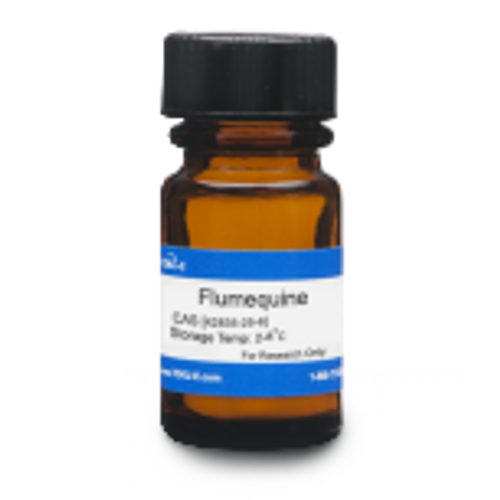Flumequine is a broad-spectrum, first-generation fluoroquinolone commonly used in veterinary research. It was patented in 1973 by Riker Labs. Flumequine is freely soluble in alkaline solutions and ethanol but is insoluble in water.
| Mechanism of Action | Fluoroquinolone antibiotics target bacterial DNA gyrase, a bacterial Topoisomerase II inhibitor that reduces DNA strain during replication. Because DNA gyrase is required during DNA replication, subsequent DNA synthesis and ultimately cell division is inhibited. |
| Spectrum | Flumequine targets primarily Gram-negative bacteria, especially those which cause infections of the intestinal tract. |
| Impurity Profile | Impurity A| (RS)-5-methyl-1-oxo-6,7-dihydro-1H,5H-benzo[i,j]quinolizine-2-carboxylic acid (defluoroflumequine)|||| Impurity B| ethyl (RS)-9-fluoro-5-methyl-1-oxo-6,7-dihydro-1H,5H-benzo[i,j]quinolizine-2-carboxylate (flumequine ethyl ester)|||| |
| Microbiology Applications | Flumequine is commonly used in clinical in vitro microbiological antimicrobial susceptibility tests (panels, discs, and MIC strips) against Gram negative microbial isolates. Medical microbiologists use AST results to recommend antibiotic treatment options. Representative MIC values include:
|
| Eukaryotic Cell Culture Applications |
Although quinolones are highly toxic to mammalian cells in culture, its mechanism of cytotoxic action is not known. Quinolone-induced DNA damage was first reported in 1986 (Hussy et al, 1986). |
| Solubility |
DMSO: Soluble |
| References |
Hussy P, Maass G, Tümmler B, Grosse F, Schomburg U (1986) Effect of 4-quinolones and novobiocin on calf thymus DNA polymerase alpha primase complex, topoisomerases I and II, and growth of mammalian lymphoblasts. Antimicrob. Agents Chemother. 29(6):1073-1078 PMID 3015015 O’Neil MJ (ed) (2013) The Merck Index- An encyclopedia of chemicals, drugs, and biologicals. Royal Soc. Of Chemistry. Cambridge, UK. P. 759 |
| MIC | Aeromonas hydrophila| 0.06 - >16 || Aeromonas salmonicida subsp. salmonicida| 0.015 - 0.25 || Aspergillus niger| 30.3|| Escherichia coli| 0.12 - 0.5 || Fusarium solani| 40.4|| Lactobacillus reuteri| 4000|| Mycoplasma gallisepticum| 2.5 - 10 || Mycoplasma hyopneumoniae| 0.25 - >16 || Mycoplasma synoviae | 5 - 50|| Pseudomonas aeruginosa| >128|| Rhizopus solani| 43.9|| |



